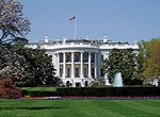|
1792
|
|
|
1800
|
|
|
1814
|
|
|
1841
|
|
8.16.1841
U.S. President John Tyler vetoes a bill which called for the re-establishment of the Second Bank of the United States. Enraged Whig Party members riot outside the White House in the most violent demonstration on White House grounds in U.S. history. |
|
|
1886
|
|
|
1901
|
|
|
1910
|
|
10.14.1910
The English aviator Claude Grahame-White lands his Farman Aircraft biplane on Executive Avenue near the White House in Washington, D.C. |
|
|
1917
|
|
8.28.1917
Ten Suffragettes are arrested while picketing the White House.
|
|
|
1922
|
|
|
1924
|
|
2.22.1924
U.S. President Calvin Coolidge becomes the first President to deliver a radio broadcast from the White House. |
|
|
1932
|
|
7.20.1932
In Washington, D.C., police fire tear gas on World War I veterans part of the Bonus Expeditionary Force who attempt to march to the White House. |
|
|
1945
|
|
1.20.1945
Franklin Roosevelt's fourth and final inauguration is held at the White House due to wartime considerations.
|
|
|
1947
|
|
|
1962
|
|
|
1970
|
|
|
1972
|
|
6.17.1972
Watergate scandal: five White House operatives are arrested for burglarizing the offices of the Democratic National Committee, in an attempt by some members of the Republican party to illegally wiretap the opposition.
|
|
11.30.1972
Vietnam War: White House Press Secretary Ron Ziegler tells the press that there will be no more public announcements concerning American troop withdrawals from Vietnam due to the fact that troop levels are now down to 27,000.
|
|
|
1973
|
|
4.30.1973
Watergate Scandal: U.S. President Richard Nixon announces that top White House aids H.R. Haldeman, John Ehrlichman and others have resigned.
|
|
|
1974
|
|
2.17.1974
Robert K. Preston, a disgruntled U.S. Army private, buzzes the White House in a stolen helicopter. |
|
7.30.1974
Watergate Scandal: U.S. President Richard M. Nixon releases subpoenaed White House recordings after being ordered to do so by the United States Supreme Court.
|
|
12.25.1974
Marshall Fields drives a vehicle through the gates of the White House, resulting in a four-hour standoff.
|
|
|
1975
|
|
|
1979
|
|
10.6.1979
Pope John Paul II becomes the first pontiff to visit the White House.
|
|
|
1989
|
|
5.4.1989
Iran-Contra Affair: Former White House aide Oliver North is convicted of three crimes and acquitted of nine other charges. The convictions, however, are later overturned on appeal.
|
|
|
1993
|
|
9.13.1993
Israeli Prime Minister Yitzhak Rabin shakes hands with PLO chairman Yasser Arafat at the White House after signing an accord granting limited Palestinian autonomy. |
|
|
1994
|
|
9.12.1994
Frank Eugene Corder crashes a single-engine Cessna 150 into the White House's south lawn, striking the West wing and killing himself.
|
|
10.29.1994
Francisco Martin Duran fires over two dozen shots at the White House (Duran is later convicted of trying to kill US President Bill Clinton). |
|
|
1998
|
|
8.17.1998
Monica Lewinsky scandal: US President Bill Clinton admits in taped testimony that he had an "improper physical relationship" with White House intern Monica Lewinsky. On the same day he admits before the nation that he "misled people" about the relationship. |
|


